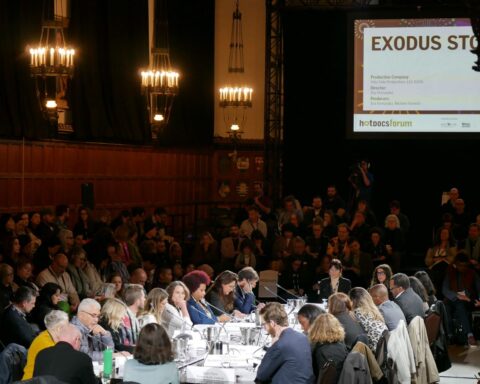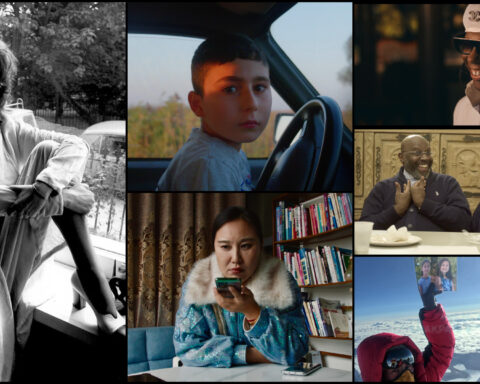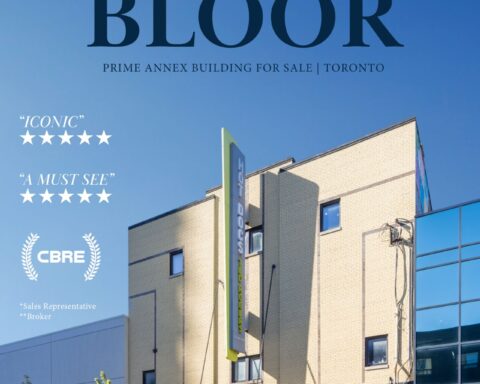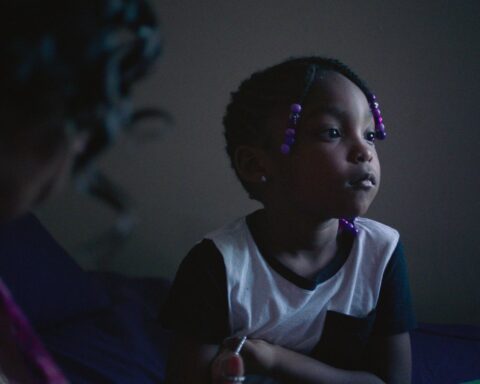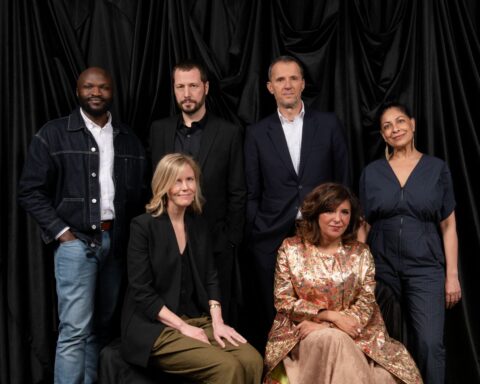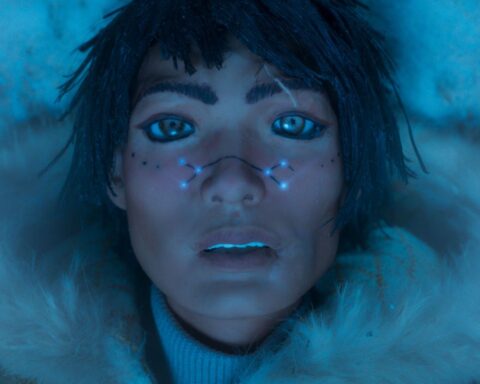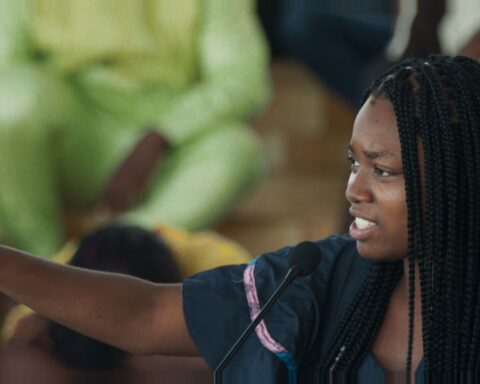While it may not have been the best-attended presentation at Hot Docs 2017, The Maribor Uprisings was surely one of its most interesting. The one-night-only screening at Innis Town Hall was guided by co-director and producer Maple Razsa, who had likewise led its world premiere at CPH:DOX in Copenhagen. With a filmography focused on the examination of protest movements, including Occupation (2002), and the “remixable” documentary Bastards of Utopia (2010), Razsa earned his PhD in anthropology and filmmaking at Harvard, and is currently an Associate Professor at Colby College in Maine. The Maribor Uprisings is Razsa’s first collaboration with co-director and DOP, Milton Guillén, and was cut by veteran editor Mary Lampson, whose career spans over 40 years, from Barbara Kopple’s Harlan County U.S.A. (1976), to Naomi Klein and Avi Lewis’s This Changes Everything (2015).
To begin, Razsa took the stage and set up the film with an introduction that connected its participatory form, which relies on the audience to guide its trajectory, with the kinds of collective decision-making practices that are common to protest movements all over the world. He took particular care to lay some ground rules for respectful participation, including a refreshing appeal for those in the audience who frequently express themselves in public forums (e.g. post-film Q&As) to make space for those who may be less outgoing and quick to speak
The backdrop for the film is Maribor, Slovenia’s second-largest city and the site of a series of “uprisings,” mass protests against government corruption that began in late 2012. The film asks us, the audience, to imagine ourselves as members of a filmmaking collective that is documenting and participating in the demonstrations. In fact, the footage of the uprisings was shot by five members of a collective that sprang into action to counter what they felt were the skewed narratives of the establishment media, which downplayed the significance of the demonstrations and depicted the protesters as hooligans. Although the film occasionally cuts away from the protests to provide context with interviews shot after the fact, the visceral and immersive footage that was captured as-it-happened with adrenaline-fueled hands goes a long way to supporting the role-playing conceit of the film.
The film is narrated by two members of the collective (portrayed by voice actors), who express their surprise that this unrest is occurring in their hometown, a place that hasn’t seen much by way of demonstrations since Slovenia achieved independence in 1991. We learn that the police have already pushed protesters out of the streets on two previous occasions and that this is the third time the citizens of Maribor have gathered under the slogan “Gotof Je!,” a proclamation to the mayor that “He’s Finished!”. As the protests build in intensity and a more aggressive faction starts to roll a hay bale towards City Hall to be torched, the film arrives at its first crucial decision point. The audience is confronted with the same choice that the protestors had to make: “Follow the Hay” and go with the rowdy and potentially violent protesters, or “Stay Here” in Liberty Square and continue demonstrating peacefully.
Razsa asks us to vote, with a show of hands, for which route to take; the vote is clearly in favour of following the hay—the more aggressive option. “Ah, you’re going to be that kind of crowd,” quips Razsa. An audience member asks whether we can see both outcomes, but Razsa reiterates that the collective decision made by the audience will be binding: just as in real life, choosing one pathway means that the other is no longer available. Interestingly, this is not the only pushback from the audience on this point; clearly there is discomfort (at least for some) in accepting the finality of the decisions that are made. The intent of the filmmakers here is clear: the inability to choose both options mirrors the experience of the actual protesters, but more importantly, as an audience, we are now keenly aware that we can only choose one pathway; we will never learn what happens on the other. Suddenly, our decisions matter more—a subtle, yet effective way of increasing the audience’s emotional investment in their decisions.
As the film progresses, we are asked to make several more decisions, although the form of each varies. For example, on one occasion, a single audience member is selected at random to decide for the group (to illustrate that sometimes individual decisions have major collective implications, explains Razsa). Perhaps the most interesting decision point in the film is when we’re asked whether we want to fight the police, or return to safety and regroup. Razsa asks for an initial show of hands (in which the audience leans towards “safety”), and then asks participants to make a case for either choice. Several individuals share their experiences from real protests in different parts of the world and what the possible consequences could have been for them if they would have chosen to fight or retreat in those types of moments. These personal stories have the effect of further heightening the stakes of our votes, reminding us that for some of our fellow audience members, these decisions are not based on what would be interesting or fun, but rather on indelible, sometimes harrowing, experiences from their pasts.
Following the discussion, we vote for a second time and find that the outcome has been tipped toward “fight.” This is the moment when the participatory form of the film feels the most apropos; unlike the passive viewing of a “normal” film, audience members are forced to engage directly with each other and not just with the screen, and the consequences of these interactions in turn affect the trajectory of the narrative. When we’re asked to vote in a group, we’re forced to reflect on what we would do in these circumstances, but because our fellow audience members can see our decisions when we raise our hands, we are held accountable for our votes in a way that’s not possible online, and at times, we may even have to justify why we’re voting a certain way. Through the discussions and politics that play out between audience members, the film meaningfully demonstrates that the line between “peaceful and violent” or “good and bad” protesters is, in actuality, very fine indeed, and that these dichotomies, created after the fact, often serve to divide protesters who share common cause. While no one would suggest that all films should be “participatory,” The Maribor Uprisings makes clear that there is a worthwhile and challenging type of filmic experience evolving here that deserves further exploration from filmmakers, programmers, and critics.
Sitting down for a chat with Razsa a few days later, we got the chance to follow up with a few questions. In terms of the technology used to present the non-linear film, we were not surprised to learn that the team had used Klynt, an “editing & publishing application dedicated to interactive storytellers” that we profiled in this magazine in 2015. As it doesn’t require writing any code, Klynt is a relatively accessible and low-tech option for small-budget projects and has come a long way in recent years. It now features integration with software like Photoshop and cloud-based video hosting such as Vimeo. As interactive storytellers ourselves, we were curious about whether there were plans to launch an online version of the film. While it’s not out of the question, Razsa and his co-director, Milton Guillén, are dubious that an online adaptation would have the same impact as the theatrical presentation.
In Razsa’s words, “The interactivity is catalyzed by the decisions that have to be made in the branching pathways of this as a non-linear documentary, but the really meaningful interactivity is what it forces to happen in the audience by reproducing some of those divides. It’s actually having to argue for the position, or being aware that you’re being swept into something you weren’t quite sure you wanted to do that makes you identify more.” Razsa explained that there is something special in the sense of accountability to the other people in the audience: “When people raise their hands, they start looking around to see what other people are doing, and I’ve seen people that came together get into arguments … like, ‘Why would you not follow the hay?’” The obvious trade-off of eschewing a web version is a much more limited audience, but that’s something that doesn’t disturb the filmmakers.
“I think about it in parallel to the significance of direct action,” says Razsa. “It doesn’t always have to be large, but intensity can matter more than scale. If the conversations are more profound, if they [the audience] think about cinema in a different way, if people might think about making a different kind of film than they would have made before, especially in a festival audience, that may have more [of a] lasting impact than wide distribution.” Whether The Maribor Uprisings does eventually find its way online remains to be seen, but in the meantime, an exciting tour is shaping up for the film, with the US premiere just announced at NYC’s Rooftop Films series in June, followed by anniversary events for the 1917 Russian Revolution, 1967 Detroit riot, and 1992 Los Angeles riots. The film will also be screened outdoors in the main square of Maribor where the uprisings began five years ago, and a “script” is in the works that will allow facilitators other than the filmmakers to present screenings of the work.




